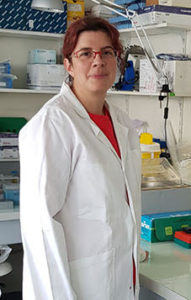Patients with myotonic dystrophy type 1 (DM1) want to know their size — the size of the expansion of repeats of the unstable CTG sequences that cause the progressive deterioration of neuromuscular functions that they might face.
Size matters to them, because it has been found to correlate with the severity and onset of symptoms, which can range from severe cardiac and respiratory abnormalities and intellectual impairment in children, to muscle weakness, hypersomnolence or cataracts in adults. The earlier the onset, the more severe the symptoms tend to be. The autosomal disorder, which is the most common form of inherited muscular dystrophy in adults, also tends to get progressively worse with each generation. But the manifestations vary widely between patients, and even within families, making it extremely difficult to predict how it will affect any individual.

Stéphanie Tomé would like to arm genetic counselors with more information to help patients navigate through their difficult diagnoses and prognoses, and to inform their decisions about their own lives and those of their offspring. Ultimately, she would also like to be able to provide them with new options to manage or even alter their diseases.
To do so, she needs to be able to read the repeats, which can be encoded in sections as large as 3,000 triplets. So she has turned to PacBio SMRT Sequencing, which is capable of capturing sequences of long stretches of DNA, including complete regions of repeats found in patients with DM1 and other expansion disorders, such as Huntington’s Disease and Fragile X.
Tomé, an investigator at the Centre de Recherche en Myologie at Sorbonne Université/INSERM in Paris, is the winner of the 2019 Targeted Sequencing SMRT Grant. Along with the 10 other scientists in her research group, led by Geneviève Gourdon, and collaborators from around the world, Tomé will sequence sections of mutated genes in DM1 patients to determine the exact size and pattern of CTG repeats.
“We have some idea of what may be going on at either end of these regions, but we don’t have any information about what is happening in the middle,” Tomé said. “Improving our knowledge of the entire repeat sequence will help us make clearer correlations between the genetic instability and the clinical manifestations of DM1.”
 Information generated in the project could also help researchers advance their understanding of some of the mechanisms behind the degenerative disorder.
Information generated in the project could also help researchers advance their understanding of some of the mechanisms behind the degenerative disorder.
If the disorder is characterized by long lengths of trinucleotides gone haywire, then it would be advantageous to be able to shrink the repeat regions back down to an asymptomatic size. Researchers have found cases where the regions have naturally contracted, and others where there are interruptions in the repeat codes.
Tomé and colleagues are pursuing this avenue of research, hoping to be able to harness knowledge about contractions and/or interruptions to induce them as a way to prevent and/or treat DM1 and other disorders. Tomé said drug screens on mouse models have already identified some potential compounds that could induce contraction, but they need to be tested and modified for use in humans.
Putting it in Perspective
Tomé admits that the data gathered from this project will likely not lead to immediate solutions, but it could provide some immediate relief to patients hungry for more insight into their disorder. And she hopes that SMRT Sequencing could become an alternative method of molecular diagnostics to ameliorate the prognosis and counseling offered to patients.
“Currently, the clinical labs tend to use Triplet Prime PCR. With this technique, we can say whether a patient is going to become sick or not sick, but it’s difficult to provide any sort of prognosis,” Tomé said. “To be able to give the patient more precise information, quickly, is very important, I think. Many patients are anxious, and don’t understand why there is so much variability between their son and daughter. They want to know.”
By collaborating with clinicians and a multidisciplinary group of 10 teams at Centre de Recherche en Myologie, Tomé embraces any opportunity to get different perspectives on the disorder, including the patient perspective.
“It’s very interesting to talk to the patients. By staying in the lab, you can lose sight of the bigger picture. By leaving the lab, you get new ideas, you learn more about what the problems are and what you might be able to do to improve the lives of patients,” Tomé said.
As the behavior of repeat regions appears similar between triplet diseases, Tomé said the project’s findings might also be applicable to 13 other expanded repeat disorders.
“This widens the potential impact of our study considerably,” she said.
We’re excited to support this research and look forward to seeing the results. Check out our website for more information on upcoming SMRT Grant Programs for a chance to win free sequencing. Thank you to our co-sponsor and Certified Service Provider, the McDonnell Genome Institute at Washington University in St. Louis, for supporting the 2019 Targeted Sequencing SMRT Grant Program.
August 19, 2019 | Corporate news